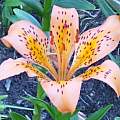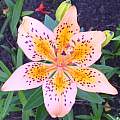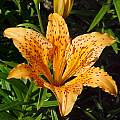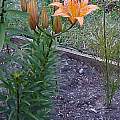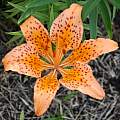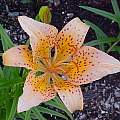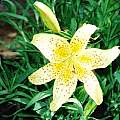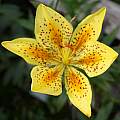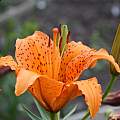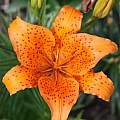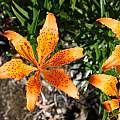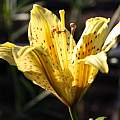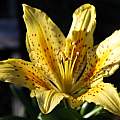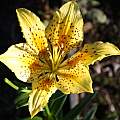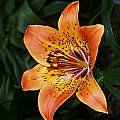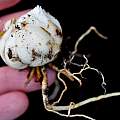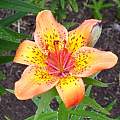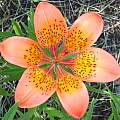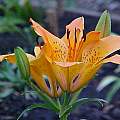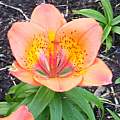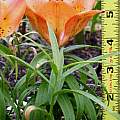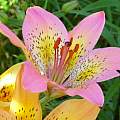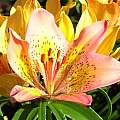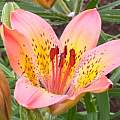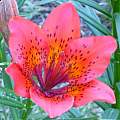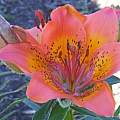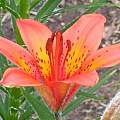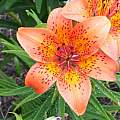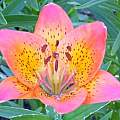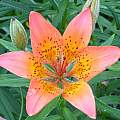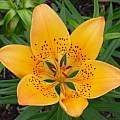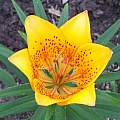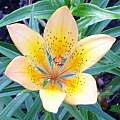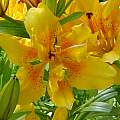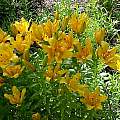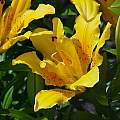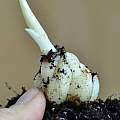Lilium is a large genus in the Liliaceae family. Information and pictures of species on the PBS wiki are found on section pages. This wiki page is for the Dauricum Section. Other sections and hybrids are linked below.
American Section a-m - American Section n-z - Asiatic Section a-c - Asiatic Section d-k - Asiatic Section l-o - Asiatic Section p-z - Candidum Section - Martagon Section - Oriental Section - Trumpet Section - Lilium Hybrids - Lilium Index
Lilium dauricum Ker Gawl. in 2022 is considered a synonym of Lilium pensylvanicum.
Lilium maculatum Thunb. is from Japan where it grows in acidic soil. For years it was grown in the west under the name Lilium wilsonii hort. ex T.Moore. There are both early and late forms with the early form flowering two to three weeks before the late form. Both forms also have some plants that produce florets with what appears to be a pink base coloration that gets covered with an orange overlay as the floret ages. They also both have plants that produce straight orange florets. There are several other forms and varieties of this species; variety monticola has a flower that is a bit smaller than the type with smaller spotting and the yellow form has a very flat floret that has little or no clawing. A couple of other forms are 'Sedogashima' and 'Shimoda'. A mature plant will grow to between 48 to 94 cm (24 to 36 inches) tall with three to 10 buds per stem. The germination form is immediate epigeal but they are slow to germinate. First three photos are of an early form, submitted by Darm Crook.
Photos four to seven are of a late form, submitted by Darm Crook.
Lilium maculatum var. flavum is not listed in World Flora Online, Plants of the World Online, IPNI, or Tropicos in 2022 although there are many online sites that show photos of it so perhaps it is just a yellow form. It flowers at the same time as L. maculatum late form. Three photos were submitted by Darm Crook.
Lilium maculatum var. monticola H.Hara flowers at midpoint between the L. maculatum early and late forms. Three photos were submitted by Darm Crook. All three photos are of seedlings from one seed lot.
Lilium maculatum crosses photos submitted by Darm Crook. The cross inside the L. maculatum family that developed this seedling was (L. maculatum var. dauricum × L. maculatum late form) × L. maculatum var. flavum. It shows some characteristics from all three parents: the flower form and spotting pattern is L. maculatum late form; the picotee tepal edges, yellow flower tone and very little pollen is like variety dauricum (now considered to be Lilium pensylvanicum), and the yellow mid rib/flash and flowering time matches the yellow form.
Lilium pensylvanicum Ker Gawl., syn. Lilium dauricum Ker Gawl., is from Asia and Siberia. It is a very diverse species, growing, depending on variety, anywhere from 13 cm to 70 cm [6 to 34 inches]. Its color ranges are also diverse; there is the standard orange and a few further colour variations such as yellow. red, pink overlay, and red overlay. It is also a species that can produce a lot of near albino seedlings. It was originally named Lilium pensylvanicum by the English botanist John Bellenden Ker (originally named John Gawler, born in 1764 in Andover) and later he renamed it L. dauricum for a region in Siberia. The original name is in 2022 the accepted name although it is still grown and sold as Lilium dauricum. First two photos below by Arnold Trachtenberg. Photo 3 of a bulb by Pontus Wallstén.
Grown in the Northwest Territories (Canada), photos below by Darm Crook
Synonym Lilium dauricum var. alpinum is not listed in 2022 in World Flora Online, Tropicos, or Plants of the World Online although IPNI lists a Lilium dauricum var. alpinum Kuzen. This variety is the hardest one of the dauricum family to grow from seed; it is slower germinating, easier to lose while in the initial stages of its growth and takes an extra year to first flower. It must be the shortest Lilium species in existence, reaching only 13 cm (6 inches) to the tip of its upright stigma; however, it has normal sized flowers. Two photos were submitted by Darm Crook.
Five photos below were submitted by Darm Crook of what he calls the pink overlay. The first three photos show three florets on one stem; the first photo is a day one floret, the second is a floret photo after being open two days, and the third is a floret photo after being open three days. This plant opens with one of the best (colour wise) pink flowers of the lily world, but being an overlay the pink fades out by the end of day three. The last two photos are simply photos of other plants showing some of the variance between the pink overlays from one cultivar to the next.
The red form comes true from seed with variations as shown in the photos. The seeds that produced this line grown in Hay River, Northwest Territories were wild collected in Siberia. The red does not fade and holds the color until the florets are finished. The plants grow to a height of 70 cm and are some of the hairiest forms there are. Five photos were submitted by Darm Crook.
The red overlay like the pink overlay fades out within three days leaving a very standard looking form. Photos submitted by Darm Crook.
Five photos showing some of the yellow colour variation were submitted by Darm Crook. of plants grown in the Northwest Territories.
Other synonyms are Lilium maculatum var. dauricum (Ker Gawl.) Ohwi and Lilium maculatum ssp. dauricum (Ker Gawl.) H.Hara. It produces very little pollen and sets seed when pollinated by any forms of the L. maculatum family. It flowers at the same time as L. maculatum early form. Five photos submitted by Darm Crook
Lilium sachalinense Vrishc is considered to be a synonym. It comes from Russian Sakhalin and was raised from material first found by Vladimir Vasak. Photo of a seedling bulb by Pontus Wallstén who comments it has a more pointed bulb than Lilium pensylvanicum and is also to a certain extent stoloniferous.
American Section a-m - American Section n-z - Asiatic Section a-c - Asiatic Section d-k - Asiatic Section l-o - Asiatic Section p-z - Candidum Section - Martagon Section - Oriental Section - Trumpet Section - Lilium Hybrids - Lilium Index
